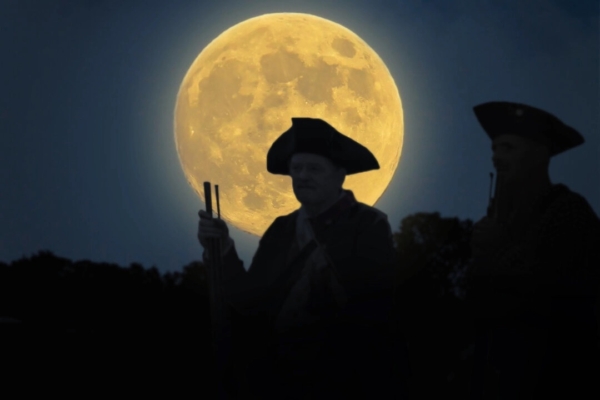The Hunter’s Moon, known for its particularly rich autumnal glow, has long been famous for aiding hunters in harvesting deer meat well into the late night before the winter freeze sets in. Rising on October 17th this month, this moon will be larger and brighter than ever before. But why is that?
It will be a Supermoon, but not just any ordinary Supermoon.
This October’s Hunter’s Moon will be the largest Supermoon of the year and the fourth and final one of 2024.
Colonial Americans in the past had to hunt for game to fill their larders before settling down in their cabins for the winter. This often led them to pursue their game well into the night, especially in open stubble fields post-harvest where deer and other large game could easily be spotted.
These nocturnal hunting activities were aided by the October Full Moon, which mysteriously rose earlier and larger than expected, providing an additional source of light specifically for their hunting endeavors.
Seemingly lending a hand with its illumination, the moon took on its traditional moniker – the Hunter’s Moon.
This year, the Hunter’s Moon will rise on October 17th, reaching its peak brightness at 7:26 am Eastern Time. It will appear low on the horizon for stargazers in North America. However, when looked at to the east during sunset, it will still appear full, akin to the nights before (October 16th) and after (October 18th). The moon doesn’t abruptly change its cycles.
Similar to September’s Harvest Moon, the October Full Moon will be a Supermoon, appearing larger and closer to the Earth than usual due to the moon’s varying distance from our planet. Our largest natural satellite orbits in an elliptical path, sometimes closer, sometimes farther away.
When the Full Moon appears near its closest point to Earth along this orbit, known as perigee, a Supermoon occurs. Just like the Harvest Moon in September, the Hunter’s Moon in October is one such instance, being the fourth and final Supermoon of the year and the largest in 2024.
On October 16th, the moon will reach perigee. At 8:57 pm Eastern Time, the moon will be 222,055 miles from Earth, about 17,000 miles closer than average. Less than 12 hours later, the Full Moon will set. A Supermoon can appear about 7% larger than normal, though this difference is often imperceptible to the human eye. It will also shine slightly brighter.
With the arrival of the Full Moon, the autumn night sky is legendary. Regardless of a Supermoon, farmers have long relied on the Full Moon in autumn to work late in the fields for harvest before the frost sets in. Folklore suggests that these Full Moons appear larger, almost mysteriously reluctant to leave, as if providing an extra brightness for the harvest.
The Hunter’s Moon typically falls in October, but not always. Full Moons in September, October, and November can sometimes interchange names. The Harvest Moon always denotes the Full Moon closest to the autumn equinox, usually in September, hence most frequently appearing in September. However, every few years, the Full Moon in October closest to the fall equinox (late September) is termed the Harvest Moon. In such instances, the Hunter’s Moon shifts to November.
It’s unusual for Full Moons to swap names during their cycles. Other months don’t adhere to this tradition. The Pink Moon in April and the Strawberry Moon in June remain consistent, and so do Moon names in other months. Moreover, most Moon names connote the entirety of that month’s lunar cycle, whereas Harvest Moons and Hunter’s Moons only refer to the Full Moon events.
Autumn Moons may appear larger than usual, but astronomers explain this as a visual illusion. Autumn Moons often rise near the horizon, where the Moon’s arc appears notably influenced by Earth’s axial tilt during the autumnal equinox. When viewed alongside ground objects like trees or buildings, they may seem larger, creating a psychological effect that makes the Moon appear grander.
Nevertheless, this is merely an illusion – the Moon illusion.
Yet the autumnal equinox is not just smoke and mirrors. Some peculiar phenomena are real, as autumn Moons follow a perplexing schedule. On average throughout the year, the Moon rises about 50 minutes later each night as it steadily moves eastward in its orbit. Around the autumn equinox, however, it may rise just 23 minutes later. This is no figment for farmers.
Astronomers attempt to explain this phenomenon. The Old Farmer’s Almanac suggests that the Moon’s arc is most extreme toward the northern latitudes in autumn, making it the lengthiest. As it rapidly shifts northward now, it seems to rise earlier than expected and ascends more swiftly the farther north it goes.
In conclusion – the Hunter’s Moon, the extra moonlight, the equinox, the Moon illusion, and the largest Supermoon of 2024 – it appears we are in for a spectacular lunar display. Autumn nights are chilly, so bundle up and spend a night under the warm glow of the Hunter’s Moon.
*Translated and paraphrased from an article originally titled “Full ‘Hunter’s Moon’ Will Be the Last and Largest Supermoon of 2024 — Here’s What You Need to Know” published on the English edition of Epoch Times website.

